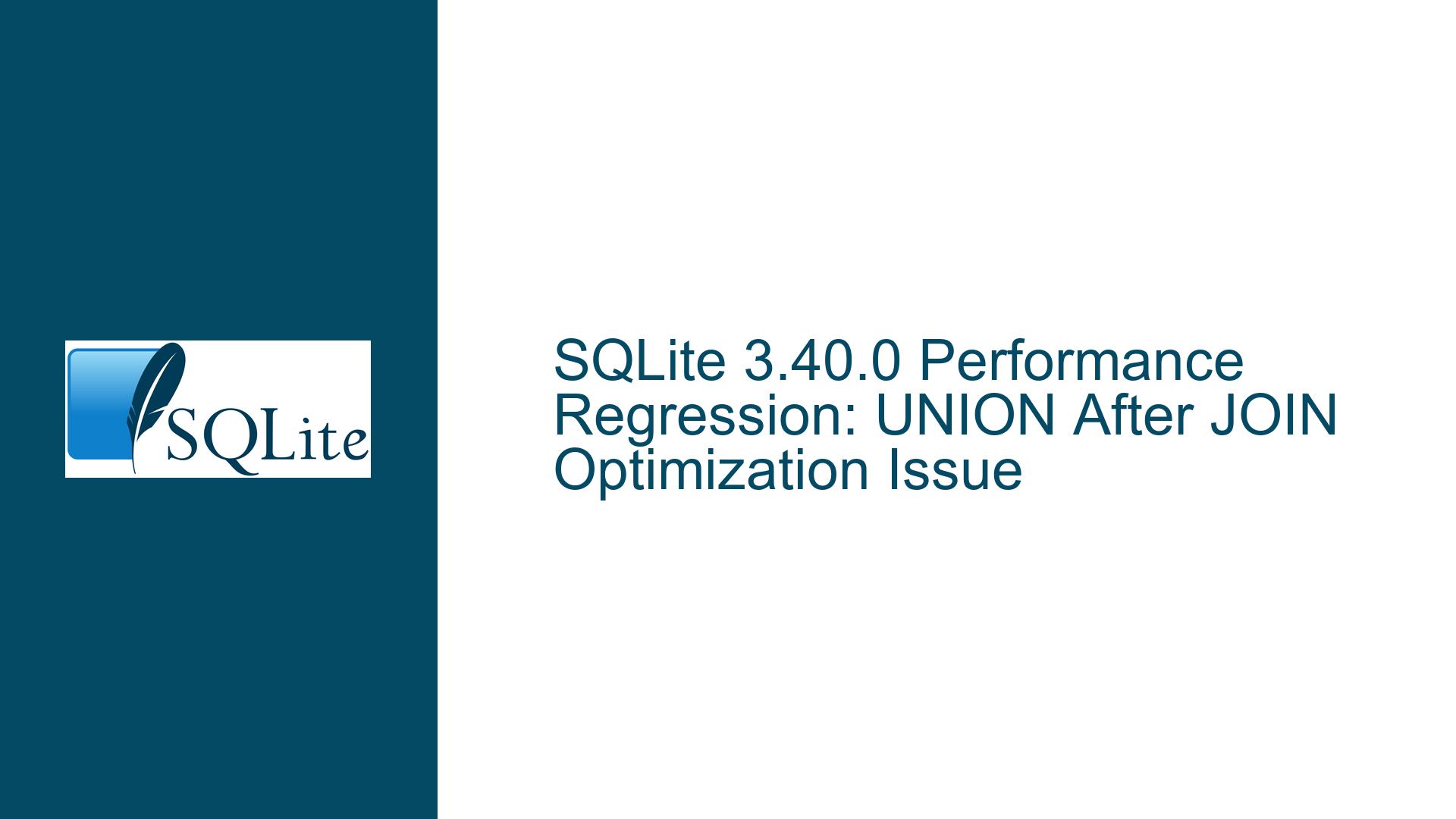SQLite 3.40.0 Performance Regression: UNION After JOIN Optimization Issue
Issue Overview: Performance Regression in SQLite 3.40.0 with UNION After JOIN
In SQLite 3.40.0, a performance regression has been identified in queries involving a UNION operation following a JOIN. This regression manifests as a significant slowdown when executing queries that combine results from multiple tables using a UNION after a JOIN. The issue is particularly noticeable when the UNION includes a constant NULL column in one of its branches, which inadvertently defeats certain query optimizations that were previously effective.
The problem arises due to a change in how SQLite handles subqueries containing compound operations (like UNION). In earlier versions, SQLite would push outer WHERE conditions into the branches of the compound operation, allowing for more efficient query execution. However, in SQLite 3.40.0, subqueries containing compound operations now act as optimization boundaries. This means that outer WHERE conditions are no longer pushed into the branches of the compound operation, leading to full table scans instead of more efficient index-based searches.
The regression is demonstrated in the following query structure:
SELECT * FROM (
SELECT a.name, z.species FROM Animal a, Zone z
UNION SELECT NULL, NULL WHERE 0
)
WHERE name = 'Fido 1';
In this query, the WHERE name = 'Fido 1' condition is not pushed down into the UNION branches, resulting in a full scan of the Animal and Zone tables. This behavior is a departure from previous versions of SQLite, where the WHERE condition would be pushed down, allowing for more efficient execution.
Possible Causes: Optimization Boundary and Push-Down Restrictions
The root cause of the performance regression lies in the interaction between SQLite’s query optimizer and the way it handles compound operations within subqueries. Specifically, the issue can be traced to two key factors:
Optimization Boundary in Subqueries with Compound Operations: In SQLite 3.40.0, subqueries that contain compound operations (such as
UNION,UNION ALL,INTERSECT, orEXCEPT) now act as optimization boundaries. This means that any outerWHEREconditions are not pushed down into the branches of the compound operation. As a result, the optimizer is unable to leverage indexes or other optimizations that would otherwise be available if theWHEREcondition were applied directly to the individual branches of theUNION.Restriction 9 and Column Affinity Requirements: SQLite’s optimizer includes a set of restrictions that govern when certain optimizations, such as push-down optimizations, can be applied. Restriction 9 specifically requires that the column affinity be the same for both sides of a
UNIONoperation. In the case of the regression, the use of a constantNULLcolumn in one of theUNIONbranches violates this restriction, preventing the optimizer from pushing down theWHEREcondition. This restriction is in place to ensure correct query results, but it inadvertently leads to performance degradation in certain scenarios.
Additionally, the issue is exacerbated by the fact that the UNION operation in the example query includes a constant NULL column. This column introduces a mismatch in column affinity between the two branches of the UNION, further preventing the optimizer from applying push-down optimizations. The result is that the query planner resorts to full table scans, which are significantly slower than index-based searches.
Troubleshooting Steps, Solutions & Fixes: Addressing the Performance Regression
To address the performance regression in SQLite 3.40.0, several approaches can be taken. These range from temporary workarounds to more permanent solutions, depending on the specific requirements and constraints of your application.
Manual Push-Down of WHERE Conditions: One immediate workaround is to manually push down the
WHEREcondition into both branches of theUNION. This approach mimics the behavior of the optimizer in previous versions of SQLite, where theWHEREcondition would be automatically pushed down. By explicitly including theWHEREcondition in both branches, you can avoid the full table scans and achieve more efficient query execution.SELECT * FROM ( SELECT a.name, z.species FROM Animal a, Zone z WHERE name = 'Fido 1' UNION SELECT NULL, NULL WHERE 0 );In this modified query, the
WHERE name = 'Fido 1'condition is applied directly to the first branch of theUNION. This ensures that the query planner can leverage any available indexes on theAnimaltable, resulting in improved performance.Avoiding Constant NULL Columns in UNION: Another workaround is to avoid using constant
NULLcolumns in theUNIONoperation. Instead, you can use a more consistent column structure that maintains the same column affinity across both branches of theUNION. This approach ensures that Restriction 9 is satisfied, allowing the optimizer to push down theWHEREcondition.SELECT * FROM ( SELECT a.name, z.species FROM Animal a, Zone z UNION SELECT 'Fido 1', NULL WHERE 0 ) WHERE name = 'Fido 1';In this example, the second branch of the
UNIONincludes a non-NULLvalue for thenamecolumn, which matches the column affinity of the first branch. This modification allows the optimizer to push down theWHEREcondition, resulting in more efficient query execution.Waiting for an Official Fix: Given that the SQLite development team is actively working on a fix for this performance regression, another viable option is to wait for an official update. The timeline for the fix is available on the SQLite website, and it is expected that the next release will include optimizations to mitigate the issue. In the meantime, you can monitor the progress of the fix and plan your upgrade accordingly.
Building SQLite from Source with Custom Modifications: For advanced users who require an immediate solution and are comfortable building SQLite from source, it is possible to apply a custom modification to revert the change that introduced the optimization boundary. This involves modifying the
select.cfile in the SQLite source code, specifically around lines 5085-5087, where Restriction 9 is enforced. However, this approach is not recommended for production environments, as it may introduce other issues or result in technically incorrect query behavior.// Example modification to select.c (not recommended for production) // Revert the change that introduced the optimization boundary if (0) { // Disable Restriction 9 // Original code enforcing Restriction 9 }After applying this modification, you would need to rebuild SQLite from source and test the changes in a controlled environment. This approach should only be used as a last resort and with a thorough understanding of the potential risks.
Exploring Alternative Query Structures: In some cases, it may be possible to rewrite the query to avoid the use of
UNIONaltogether. For example, you could use aLEFT JOINor aCOALESCEfunction to achieve similar results without encountering the performance regression. This approach requires careful consideration of the query logic and may not be applicable in all scenarios.-- Example using LEFT JOIN instead of UNION SELECT a.name, z.species FROM Animal a LEFT JOIN Zone z ON a.name = 'Fido 1' WHERE a.name = 'Fido 1';In this example, the
LEFT JOINoperation is used to combine theAnimalandZonetables, avoiding the need for aUNION. This approach can result in more efficient query execution, depending on the specific requirements of your application.
Conclusion
The performance regression in SQLite 3.40.0 involving UNION after JOIN is a complex issue that stems from changes in the query optimizer’s handling of compound operations within subqueries. By understanding the underlying causes and exploring the various troubleshooting steps and solutions outlined above, you can mitigate the impact of this regression and maintain efficient query performance in your SQLite-based applications. Whether you choose to implement manual workarounds, wait for an official fix, or explore alternative query structures, it is important to carefully evaluate the trade-offs and ensure that your solution aligns with the specific needs of your application.






